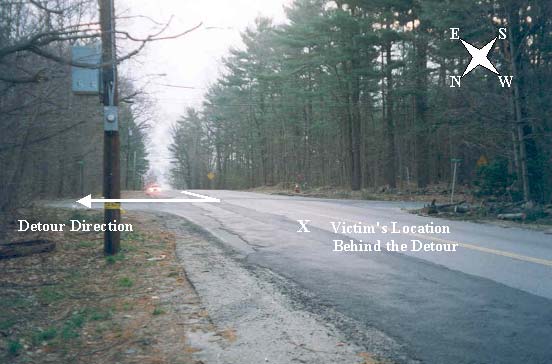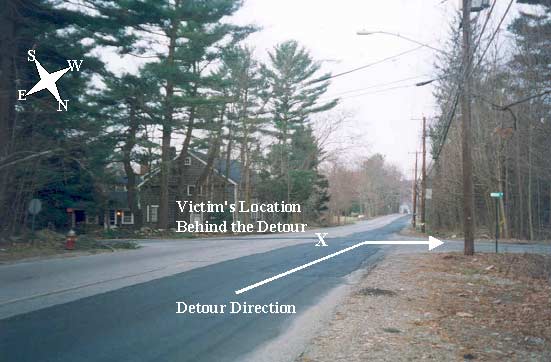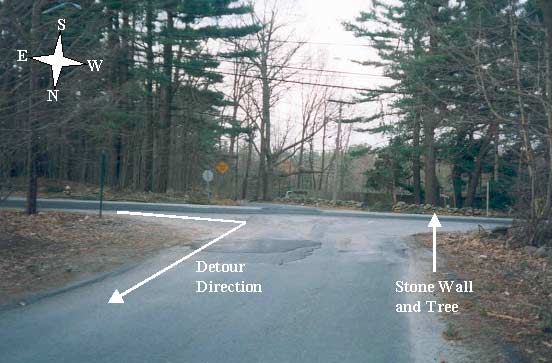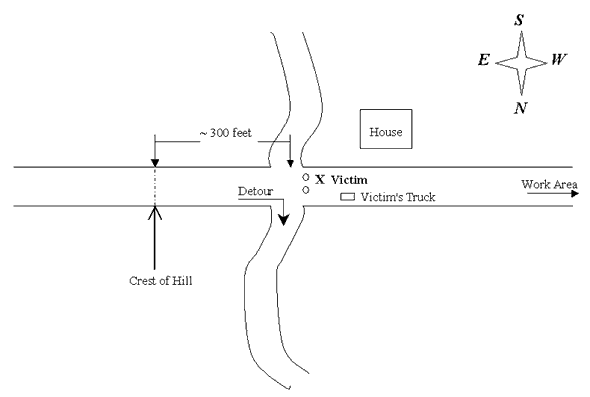Police Officer Killed When Struck By Motorist While Directing Traffic At Roadway Work Zone
Investigation: # 00-MA-54-01
Date: December 20, 2001
SUMMARY
On September 21, 2000, a 38-year-old male police officer (the victim) was fatally injured when a motorist intruded into a roadway work zone striking him. The victim was standing at a four-way intersection directing traffic through a detour. The main flow of traffic followed the detour making a right-hand turn at the four-way intersection. The motorist that struck the victim failed to turn right at the construction site detour, and her pickup truck skidded sideways through the detour, striking the victim, then striking the victim’s parked truck and finally coming to a stop partially on top of a stone wall and against a tree. A call was placed for emergency assistance and the victim was transported to a local hospital where he was pronounced dead. The Massachusetts FACE Program concluded that to prevent similar occurrences in the future, employers/highway construction contractors should:
- ensure that the work zone is setup, at a minimum, in accordance with the Manual on Uniform Traffic Control Devices (MUTCD), Part 6 developed by the U.S. Department of Transportation Federal Highway Administration
- consider portable rumble strips to alert motorists to the changed roadway conditions
- consider area objects and the work site background when choosing colors for worker apparel
In addition, local and state government agencies should:
- consider work zone safety training and certification for all municipal officers who perform traffic details on roadway construction sitesAlso, state government agencies should:
- consider developing state laws that impose increased fines for motorists speeding within roadway work zones
INTRODUCTION
On September 21, 2000, the local media notified the Massachusetts FACE Project that on the same day, a 38-year-old male police officer was fatally injured when he was struck by a motorist that had intruded into a roadway construction site. An investigation was immediately initiated. On September 29, 2000, the Massachusetts FACE Project Director traveled to the incident site and to the incident town’s police department, where the chief of police and two officers were interviewed. In addition, the death certificate was obtained during the course of the investigation.
The victim had been employed with a neighboring town’s police department as a full-time police officer for approximately three years. Both the town where the incident occurred and the town the victim was employed with participated in a mutual aid program. The program provided help to towns that do not have sufficient police officers to cover the events that require officer details. Under this program, the town in need of additional officers can borrow as many officers as needed from the participating towns to cover shifts. Typically, mutual aide work is in addition to the officers’ regular work schedule, but it was unclear if this was the case in this incident.
The town where the incident occurred has been incorporated since the late 1800’s and employed approximately 15 police officers at the time of the incident. It was unknown how many mutual aid officers, in addition to the victim, were working for the town on the day of the incident. Typically, in Massachusetts, municipal police officers do not receive specific roadway work zone safety training.
INVESTIGATION
At the incident location, sewage pipe was being replaced in preparation for a large, two-stage roadway repaving construction project. A private contractor was conducting the sewage pipe replacement, and an engineering consultant designed the work zone set up, which was approved by the town police and the Department of Public Works.
The incident occurred at a four-way intersection involving a main roadway on the outskirts of a suburban town. The roadway under construction was asphalt, and approximately 27 feet wide. It consisted of two lanes, which ran east and west. The pavement markings consisted of solid double center yellow line and white fog lines. The road had a no drivable shoulder, and had a few feet of grass and underbrush on each edge before larger trees took over. At the four-way intersection, where the incident took place, traffic was being detoured onto a perpendicular road, which ran north and south. This road was smaller and less traveled than the main road. A hill crested approximately 300 feet east of the detour, on the main road, and the hill continued to decline past the detour turning point. When traveling on the main road heading west, the hill obscured the detour entrance (see attached figures).
Several weeks before the incident, the work area had been located at the north shoulder of the main roadway. The work zone at this time had narrowed the westbound travel lane and shifted westbound motorists to the south away from the work area. Approximately four days prior to the incident, the detour had been implemented daily between the hours of 7:00am and 4:30pm because the work was progressing towards the middle of the main road. Detour signs directed motorists traveling west on the main road to turn right at the four-way intersection and to travel around the work area on adjacent roads. The detour eventually located them back on the main roadway past the work area.
The section of the main roadway leading up to the work zone, heading west, contained up to five warning signs. The first warning sign was posted approximately ¾ of a mile before the detour. It appeared that the warning signs stated “roadwork” and “detour ahead”, but did not state that the road ahead was closed.
On the day of the incident, the victim drove his personal truck to the construction site and parked inside the work zone. The detour had been setup at its usual time, approximately 7:00am. In addition to the construction activities that morning, an evacuation of the surrounding houses was underway because of a gas main leak, caused by the construction work (see Figure 4).
The victim was wearing an orange traffic vest and white gloves and had been assigned to the east end of the work zone detour. He was standing approximately 10 feet behind the detour barricade which consisted of three orange barrels and two signs. He was directing and slowing down the motorists as they entered and exited the detour.
A line of traffic, including the motorist involved in the incident, was traveling west on the main road leading to the detour when the motorist involved in the incident switched lanes. The motorist crossed over the double yellow lines and positioned her pickup in the left lane, which was for oncoming traffic, and continued traveling west towards the detour passing the other motorists on the left. Once her pickup was over the crest of the hill in the road, it appeared that she noticed the detour and applied the brakes. The pickup skidded sideways and crashed through the detour barricade, consisting of the orange barrels and warning signs. The passenger side of the pickup truck first struck the victim, then struck his parked truck and then finally came to a stop partially on top of a stone wall, and against a tree. A call was placed for emergency assistance and the victim was transported to a local hospital where he was pronounced dead.
The driver of the pickup truck that struck the victim was charged with vehicular homicide. Once the driver was charged, many individuals that would normally be contacted in a FACE investigation where not willing to talk about the case due to legal reasons or on the advise of their attorneys.
CAUSE OF DEATH
The medical examiner listed the cause of death as multiple traumatic injuries.
RECOMMENDATIONS/DISCUSSION
Recommendation #1: Employers/highway construction contractors should ensure that the work zone is setup, at a minimum, in accordance with the Manual on Uniform Traffic Control Devices (MUTCD), Part 6, developed by the U.S. Department of Transportation Federal Highway Administration.
Discussion: The Manual on Uniform Traffic Control Devices (MUTCD) sets forth the basic principles that govern the design and usage of traffic control signs and devices. The MUTCD provides uniform designs and setups of work zones for roadway construction, maintenance, and utility operations.
On the day of the incident, the roadway was closed down and motorists were detoured around the work site. Warning signs leading up to the detour stated that there was roadwork and a detour ahead. Following the MUTCD minimum standards and guidelines recommended in Part 6, a “road closed” warning sign containing the distance to the closure should have been setup in the advanced warning area of the work zone. 1 Such a sign might have caught the motorist’s attention alerting her to the major alteration to the roadway.
In addition to the MUTCD required signs and barrels, which will not physically stop a motorist from intruding into a work zone, devices such as concrete barriers that might supply higher levels of safety to workers inside the work zone, should be considered.
Recommendation #2: Employers/highway construction contractors should consider portable rumble strips to alert motorist to the changed roadway conditions.
Discussion: Highway construction projects face the challenge of getting motorist’s attention and getting them to slow down. Portable rumble strips provide a vibratory and audible warning for motorists that can be used in addition to signage. According to the Strategic Highway Research Program (SHRP), funded by Federal Highway Administration (FHWA), the first rumble strip should be placed at a minimum of 250 feet from the traffic condition. 2 A sign, warning drivers of the rumble strip, should be placed in advance of the rumble strip. Then additional rumble strips should be used leading up to the detour or work area.
In this case, a hill crested approximately 300 feet east of the four-way intersection and detour. Portable rumble strips could have been placed on the road prior to, during, and after the crest of the hill giving motorists plenty of secondary warning to observe the detour turnoff if they missed the previous signs posted in the advanced warning area.
Recommendation #3: Employers/highway construction contractors should consider area objects and the work site background when choosing colors for worker apparel.
Discussion: Employers should require all workers on foot to wear high-visibility safety apparel on construction sites. When choosing worker apparel, to ensure that workers do not blend into the background of the construction site (consider seasonal variation in landscape and foliage) or be mistaken for traffic signs or traffic barrels, employers should consider apparel colors for enhanced worker safety. 3
In this case, the victim was wearing a red-orange traffic vest and standing in the vicinity of many red-orange traffic signs and barrels. If the victim had been wearing a high visibility traffic vest that was fluorescent yellow-green, this might have better distinguished him from the many red-orange objects surrounding him.
Recommendation #4: Local and state government agencies should consider work zone safety training and certification for all municipal officers who perform traffic details on roadway construction sites.
Discussion: Training and certifying municipal officers in roadway work zone safety, including work zone setup and design, will provide them the knowledge to better protect not only themselves, but also construction workers, pedestrians, and motorists. This training should be based, at a minimum, on the MUTCD, Part 6, which governs work zone designs, and updated annually. The possibility of extending training to include other hazards common on construction sites, such as trenching and electrical hazards, should also be considered.
The Massachusetts state police train their troopers in roadway work zone safety. This existing training course could be used as an outline to develop training for local city and town officers.
Recommendation #5: State government agencies should consider developing state laws that impose increased fines for motorists speeding within roadway work zones.
Discussion: Currently, in Massachusetts and across the country, there is a great deal of construction work being carried out on and next to our roadways due to increased federal funding allocated for the rehabilitation of existing highways. One strategy to promote the safety of both workers and motorists around roadway work zones is to discourage motorists from speeding by imposing increased state fines for those caught speeding inside work zones.
Many states, not including Massachusetts, have instituted double fines for motorists speeding inside work zones. However, few studies have been conducted to evaluate the effectiveness of these increased fines. One study, carried out by the Texas Department of Transportation and the U.S. Department of Transportation, Federal Highway Administration, found that, overall, states that enacted legislation to increase fines in work zones did not experience significantly lower fatal accident rates than states without fines. However, findings did differ greatly from state to state. 4
Most states that have increased fines for speeding in work zones do not have law enforcement officers present for enforcement of the speed limits, likely limiting the effectiveness of the increased fine legislation. Massachusetts is in a unique position because law enforcement officers are already present at most large roadway construction sites, which could facilitate enforcement of increased fines for speeding in work zones.
REFERENCES
- Manual on Uniform Traffic Control Devices (MUTCD), 1988 Edition, Revision 3, September 3, 1993, Revision No. 4, issued January 4, 1995 and Errata No. 1, issued April 11,1995, (15M-11-96), Part VI. Standards and Guides for Traffic Controls for Street and Highway Construction, Maintenance, Utility, and Incident Management Operations, U.S. Department of Transportation Federal Highway Administration, printed by American Traffic Safety Services Association, Fredericksburg, VA.
- Strategic Highway Research Program (SHRP), New Devices Gives Drivers an Audible Warning of Upcoming Work Zone, U.S. Department of Transportation, Federal Highway Administration, Publication No. FHWA-SA-96-045 (CS103)
- NIOSH 2001. Building Safer Highway Work Zones: Measures to Prevent Worker Injuries from Vehicles and Equipment, Department of Health and Human Services, Center for Disease Control and Prevention, National Institute for Occupational Safety and Health, DHHS (NIOSH) Publication No. 2001-128
- Work Zone-Related Traffic Legislation: A Review of National Practices and Effectiveness, Gerald L. Ullman, Paul J. Carlson, Nada D. Trout, J. Alan Parham, Texas Transportation Institute, Texas Department of Transportation, U.S. Department of Transportation, Federal Highway Administration, September 1997
FIGURES

Figure 1 – The arrow indicates the detour direction. This is the same direction the motorist was traveling (west) prior to striking the victim. Note the crest of the hill, which would obstruct the driver’s view.

Figure 2 – This shows the road from the perspective of a motorist traveling west. The arrow indicates the detour direction.

Figure 3 – Smaller cross road that the traffic flow was detoured onto.

Figure 4 – Diagram of the incident site.
To contact Massachusetts State FACE program personnel regarding State-based FACE reports, please use information listed on the Contact Sheet on the NIOSH FACE web site Please contact In-house FACE program personnel regarding In-house FACE reports and to gain assistance when State-FACE program personnel cannot be reached.
